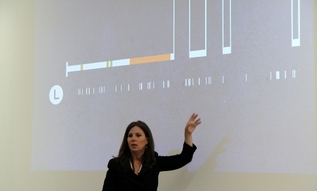|
Earlier this quarter, Nancy Duarte spoke to us at UCLA Anderson about presentation design. She's the author of two great books on the subject: slide:ology and Resonate, and her firm designs presentations for extremely influential business leaders and politicians, in addition to teaching people how to design impactful slides. She started her talk with a personal story about herself and then gave us a debrief on what she just did. She explained the structure of her introductory story as a structure we can use for any story meant to grasp people's attention:
She said that PowerPoint should not be an exhaustive report; it should be visual and persuasive. You can save the details for handouts to give people at the end. If you have to give a report, give an executive summary, distribute it as a document, let the audience read it, and then just discuss as human beings. That's a lot better than cramming numbers in a PowerPoint. Only project visuals that are mnemonic for the audience to remember your message, not for you to remember what to say. Start your presentation with a unique point of view and the stakes for the audience. Incorporate story to show the transformation of a hero from beginning to end. This can apply to business presentations where a team that performs an analysis and comes up with a result can be the hero. To bring it to a more subtle level, she argues the presenter is actually not the hero; the audience is the hero. The presenter's role is that of mentor or yoda. She spent months studying dramatic story structure from classic Greek dramas to the most effective speeches of all time (MLK, Gandhi, Neru, Steve Jobs). She studied the visual/emotional shape of story to come up with a sine wave representing going back and forth between "what is now" and "what could be." She says this is the secret to taking your audience on a ride with you through your speech. Her argument definitely seemed persuasive to me. She broke down every second of Steve Jobs' iPhone launch PowerPoint that she worked on and pointed out his strategies to us. She pointed out how he literally marveled at his own product and modeled the emotion he wanted his audience to feel. The "star" moment was something they'll always remember: when he turned on the iPhone for the first time and showed scrolling. Jobs mentioned Wayne Gretzky in his speech, quoting "skate to where puck is going to be, not where it has been." From MLK and Neru's speeches, we learned about the use of metaphor, repetition, political reference, scripture, and emotions. In terms of connecting to audiences, Duarte's happy that people can now give live feedback on Twitter as they're listening to good or bad speakers. She advocates addressing hostile reactions explicitly in one's talk in order to inoculate them. She spent some time also describing her creative process. She first storyboards everything with Post It's that she can then move around. She does this to find holes. Then she just puts the Post It's into PowerPoint. Some useful links: Below are two related videos as well: The Five Rules presentation, and her TEDxEast talk on uncovering the common structure of the best communicators. Overall, the talk was useful, and as a personal lover of clean, simple, visual slide design, I definitely enjoyed meeting Nancy and hearing her speak.
1 Comment
2/23/2011 10:50:44 pm
Hi Max,
Reply
Your comment will be posted after it is approved.
Leave a Reply. |
Archives
June 2024
Categories
All
Subscribe |

 RSS Feed
RSS Feed
